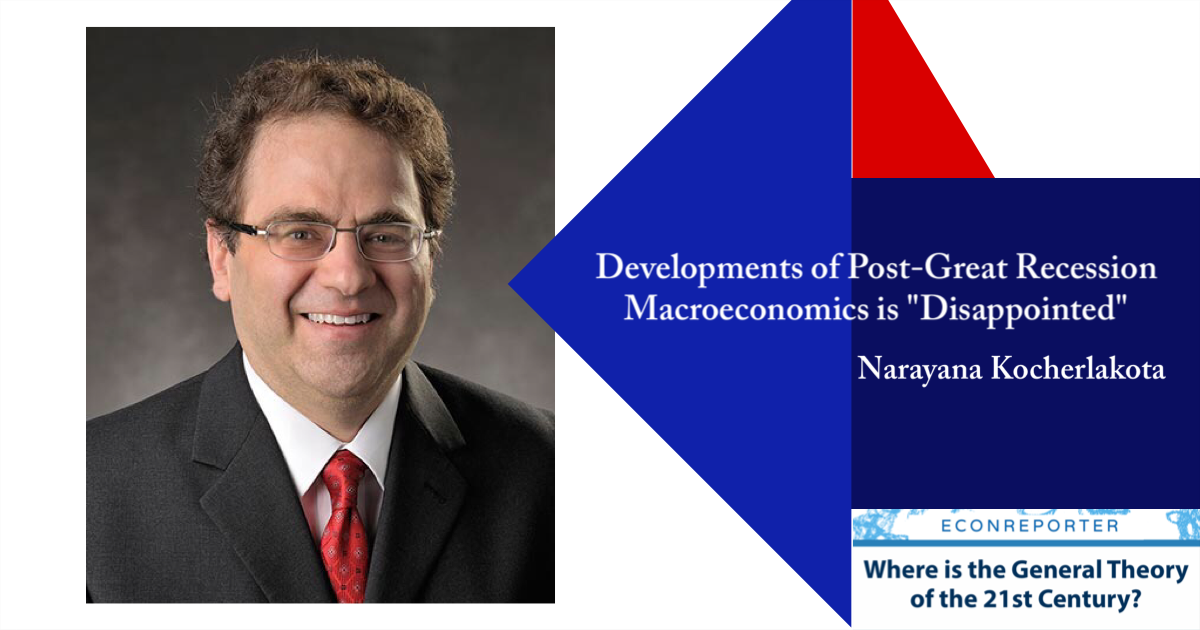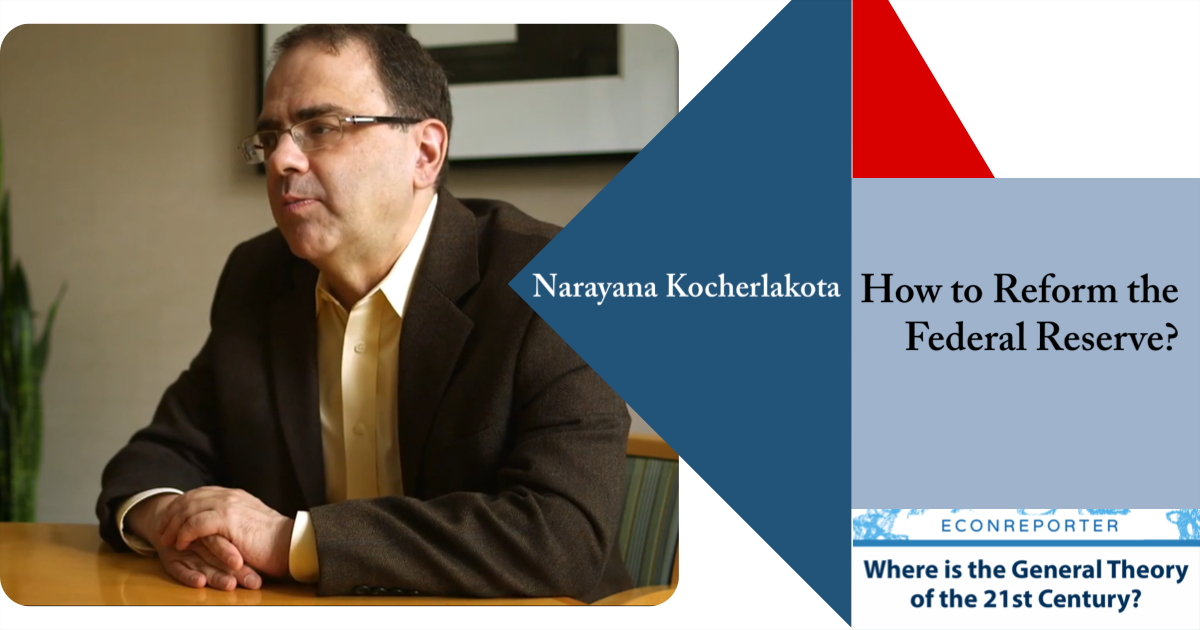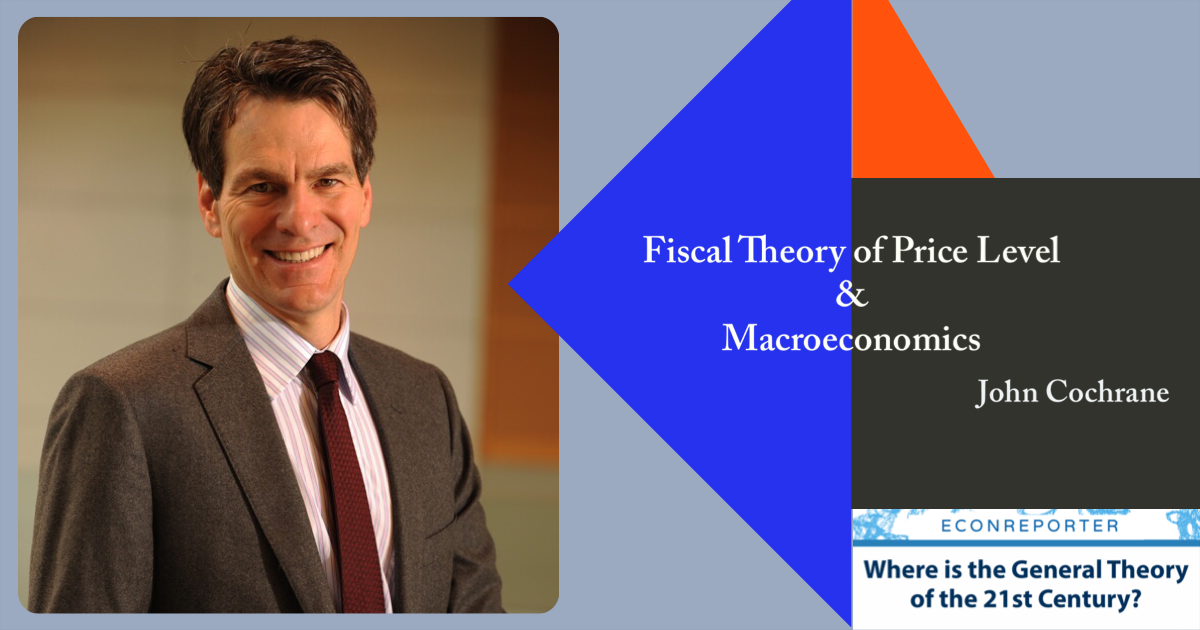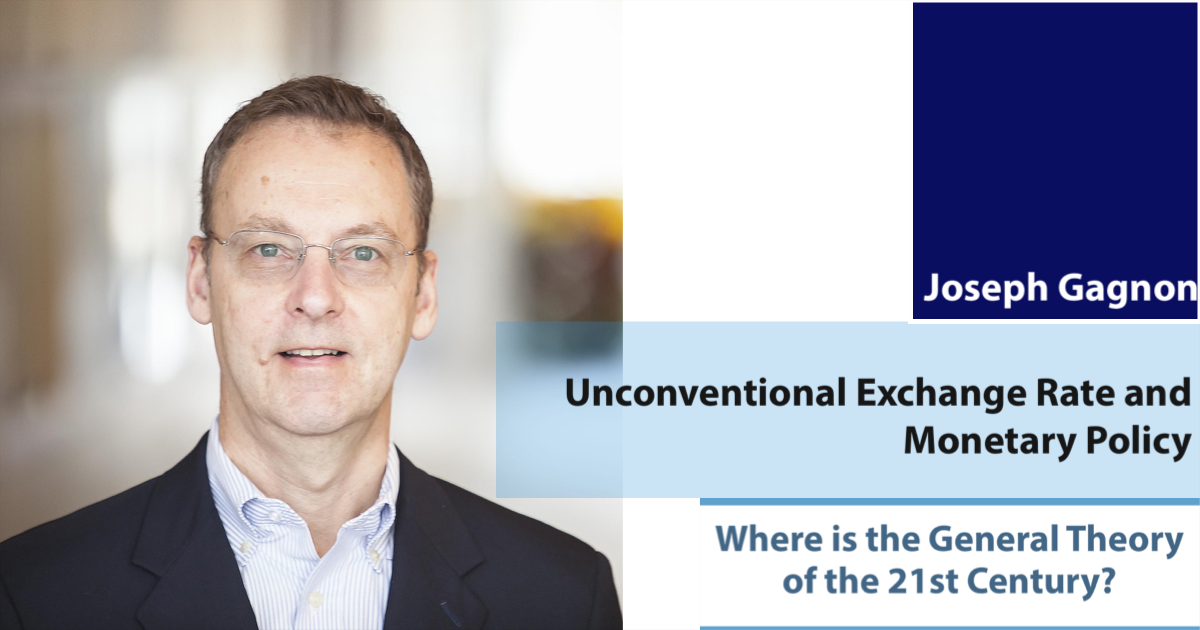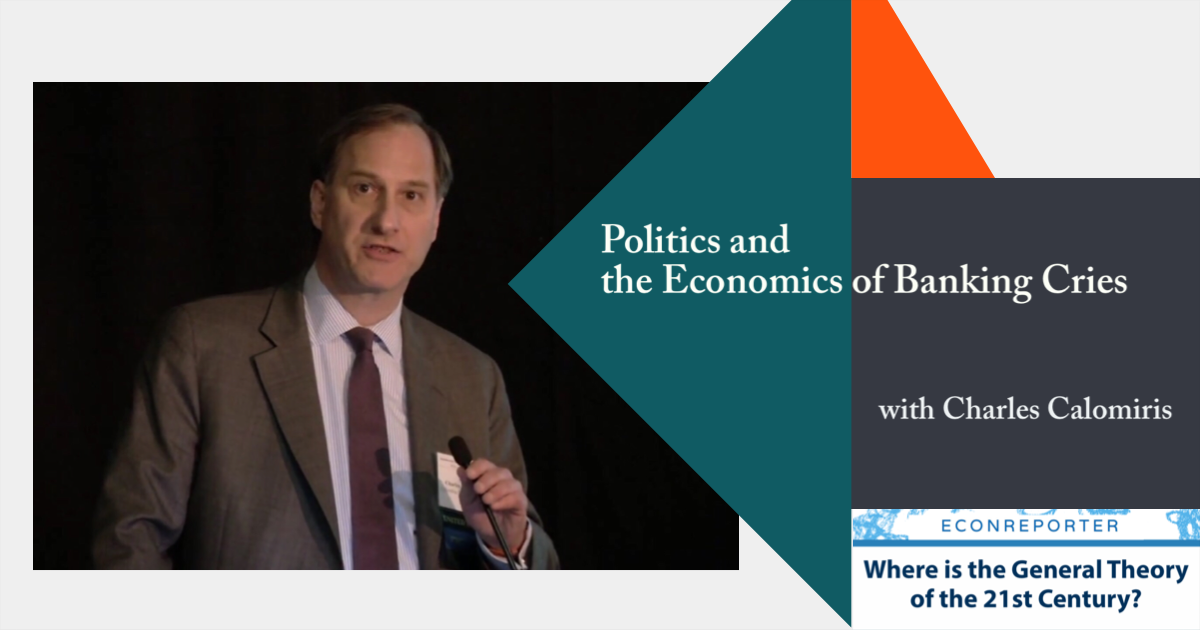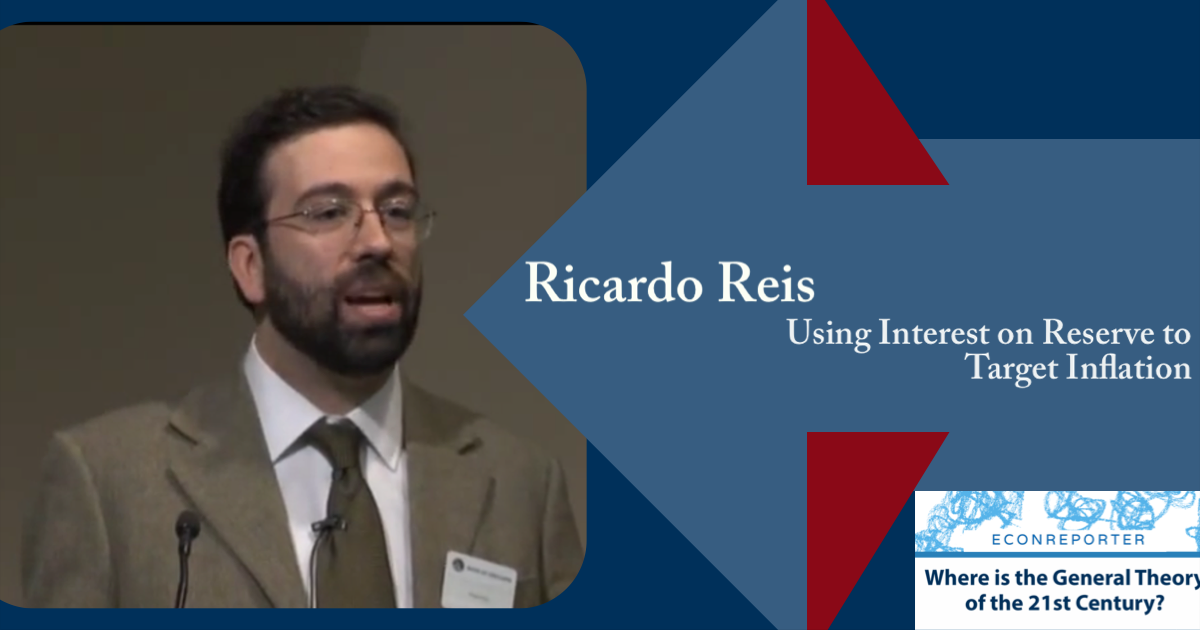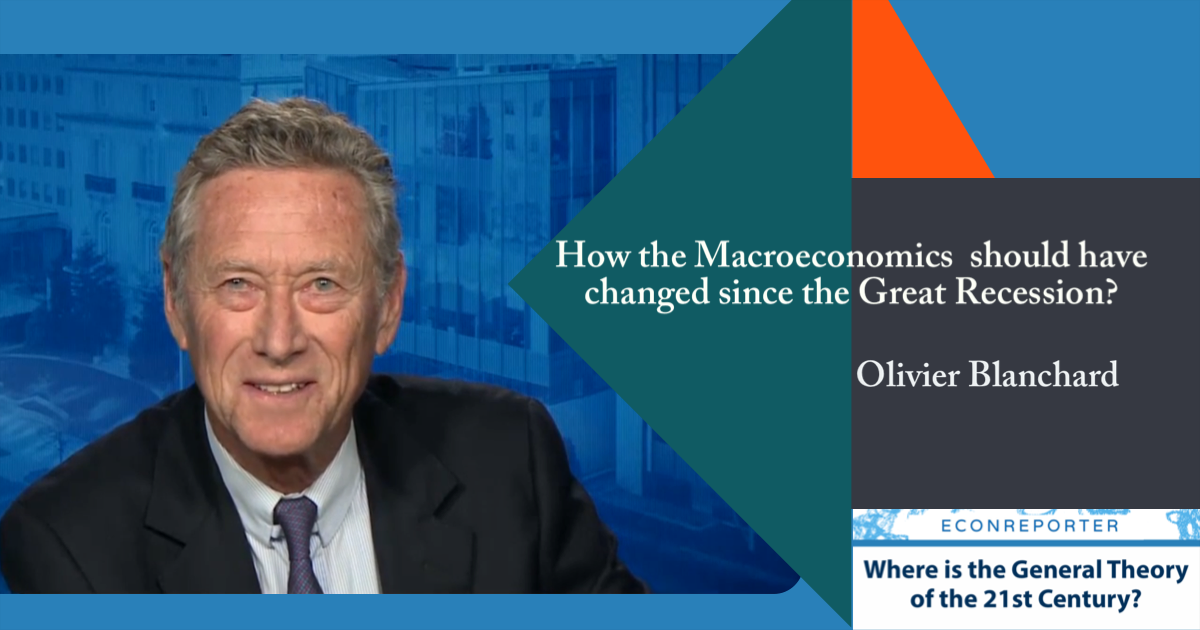Welcome to the latest installment of our interview series “Where is the General Theory of the 21st Century?”
“Where is the General Theory of the 21st Century?” is an interview series which we ask top economists a very important question: “Why haven’t economists come up with a new General Theory after the Great Recession?” We want to know how the macroeconomics academia has evolved since the Great Recession, and why the responses from macroeconomists since 2008 are different from their counterpart in the 1930s.
Kocherlakota on How to Reform the Federal Reserve System | #WITGT21 Interview Series |
Welcome to the latest installment of our interview series “Where is the General Theory of the 21st Century?” “Where is the General Theory of the 21st Century?” is an interview series which we ask top economists a very important question: “Why haven’t economists come up with a new General Theory …
This is the second part of our discussion with Prof. Narayana Kocherlakota, professor of economics at the University of Rochester and the President of the Federal Reserve Bank of Minneapolis from 2009 to 2015. Prof. Kocherlakota explains why he is “disappointed” with post-2008 macroeconomics. Also, he explains why he no longer agree with his own “Neo-Fisherian” he has make in a speech in 2010.
(The interview is edited for clarity. All mistakes are ours.)
Q: EconReporter K: Narayana Kocherlakota
Q: Do you think that after the Great Recession, macroeconomics has gone through an evolution that is comparable to Keynesian Revolution?
K: I have been back to academia for just over a year but I don’t see any signs of a revolution of that kind taking place. I think where academic macroeconomics now stands is just the continuation of trends that were already in place before the Great Recession. There is much interest in trying to develop models with more respect for heterogeneity on the firm side and the household side, using sophisticated computational methods and data. But these are just continuations of trends that were in place before the Great Recession.
I am disappointed by that. I think that the financial crisis and the slow recovery after that should really make macroeconomists revisit and rethink the path we are on, but I don’t see very much of that happening at this stage.
Q: I have done several interviews on this question, you seem to be the first to use “disappointed” to describe the situation. Some of them mentioned the trend of reviving old theories are constructive at the very least. So, in what way do you think that macroeconomists can do better?
K: I think there is a lot of answers to that question. I do think that the apparatus that we have built up, say, going into August of 2008 has been revealed to have certain faults.
Let’s talk about some specifics. One thing I think everyone agrees on is that we have left out the financial sector, to the extent that macroeconomics models miss certain important aspects of what was building up in both the United States and around the world. We do see some people trying to work on that.
In the US, people tell themselves a story that it is just a slowdown in productivity growth that we are seeing, resulting in a lower economic growth than what we would have expected ten years ago. But in my view, it is very hard to tell those kinds of stories when you look at Greece and Spain.
Basically, I think we have to build models that allow for persistent low aggregate demand. That’s my own take away from this experience. We need to have a model on the table to explain why aggregate demand is low relatives to the potential in the economy for many years. We don’t have much in the way of the models like that in this stage.
Q: Have you seen any new developments and research that you think will bring “hope” for the future of the macroeconomics?
K: On the financial side, I think there has been a lot of good work. Markus Brunnermeier and Yuliy Sannikov’s work, for example, I think is very interesting. Some of the work Mark Gertler has done with Nobuhiro Kiyotaki and other coauthors, trying to build more of the financial sector into the standard models. I think it’s helpful.
Mark has a paper that he wrote early last year on the medium-run business cycle [Endogenous Technology Adoption and R&D as Sources of Business Cycle Persistence]. That’s a very positive agenda building on the work with Diego Comin. I like that quite a bit.
But I think a lot more could be done to try to bring in a more realistic vision of the household sector, how it interacts with the financial sector, and how firms interact with the financial sector. I think we need to understand how an economy can build up imbalances in the financial sector which lead to the real shortfall in the aggregate demand relative to the potential for a prolonged period of time. That I don’t see.
Q: You have a very famous speech back in 2010 hinting that you are supportive of the idea of Neo-Fisherian. Seven years on, do your opinion on the Neo-Fisherian View changed?
Here is the relevant part of the speech “Inside the FOMC” Prof. Kocherlakota made back in August 2010:
The fed funds rate is roughly the sum of two components: the real, net-of-inflation, return on safe short-term investments and anticipated inflation. Monetary policy does affect the real return on safe investments over short periods of time. But over the long run, money is, as we economists like to say, neutral. This means that no matter what the inflation rate is and no matter what the FOMC does, the real return on safe short-term investments averages about 1-2 percent over the long run.
Long-run monetary neutrality is an uncontroversial, simple, but nonetheless profound proposition. In particular, it implies that if the FOMC maintains the fed funds rate at its current level of 0-25 basis points for too long, both anticipated and actual inflation have to become negative. Why? It’s simple arithmetic. Let’s say that the real rate of return on safe investments is 1 percent and we need to add an amount of anticipated inflation that will result in a fed funds rate of 0.25 percent. The only way to get that is to add a negative number—in this case, –0.75 percent.
To sum up, over the long run, a low fed funds rate must lead to consistent—but low—levels of deflation.
K: Certainly, my view evolved a lot since I spoke in 2010. There was a lot of criticism in the blogosphere to what I said in the speech that you mentioned. I didn’t necessarily buy into the criticism immediately but it certainly gave me pause.
I think it is notable that I gave a speech that was almost identical two or three weeks later but it didn’t include the part about the Neo-Fisherian view. I thought enough people had raised enough concerns that I wanted to think about the issues more.
At this point, I would certainly want to distance myself from what I said in 2010. Why is that? In the speech, I claimed that, no matter what monetary regime the central bank was following, we would end up having the real interest rate converge to the same optimal level. The claim now doesn’t seem right to me. The nature of the nominal regime the monetary authority and fiscal authority are following will have an impact on the real interest rate. So I think the claim that I’ve made in that speech that we know where the real interest rate is going to be in the long run, I just don’t think that is correct. I think that the long-run real interest rate is policy dependent. Without taking that into account, one just can’t make the claim that I’ve made at the time that keeping the nominal interest rate low is necessarily going to lead to lower expected inflation.
Q: One thing we have observe in the recent years is that the Neo-Fisherian seems to be right. For example, when we are raising the interest rate in the last two years, we can see the inflation is actually going up. Though we are not sure about the causal relationship, this seems…
K: I would have to push back on that. I think this is not right. We are seeing central banks raising interest rates because economic conditions improved. Improved economic conditions are associated with improvement in inflation expectations. In the Fed’s case, one of the reasons they feel it is safe to raise rates is because inflation expectations have improved. So, the causation is all running in the opposite direction.
There is a perspective that this is really a debate about whether the Fisher Equation holds or not. No, it’s really a question of what elements do we view as exogenous or endogenous in the Fisher Equation.
The Neo-Fisherian perspective is that, over the longer run, the real interest rate can somehow be viewed as exogenous. That means that, over the longer run, the expected inflation rate will track the central bank’s setting of the nominal interest rate… I just think there is no evidence to back that up. Having said that, I think it’s a debate that is really a challenging one to sort out using data. Because we all agree that the Fisher equation is valid. What we disagree about is what’s exogenous and what’s endogenous in the equation.
Q: For example, Prof. John Cochrane is incorporating the Neo-Fisherian view into the Fiscal Theory of Price Level framework (Readers can read our previous interview with Cochrane to learn more about his views) Do you think incorporating the Neo-Fisherian view is not a viable way forward?
John Cochrane on What is Neo-Fisherian? | #WITGT21 Interview Series |
Welcome! This is the third installment of our interview series “Where is the General Theory of the 21st Century?” “Where is the General Theory of the 21st Century?” is an interview series with the aim to ask top economists a very important question: “Why haven’t economists come up with a …
K: I think John’s work on the FTPL is valuable and useful. The mistake I’ve made in the speech in 2010 is that I think that real interest rate is going to settle down where we want them to be, no matter what the government does in terms of monetary and fiscal policy. It was incorrect. From a policy point of view, it is even dangerous. I think unless you have the right monetary and fiscal regime in place, you can’t be sure about that kind of long run stability in the real interest rate.
I think John is getting to that point. He is trying to identify the aspects of the regimes that are in place will lead to the stability that we have seen. We have not seen the kind of decline in inflation expectations that many were afraid of in the 2009 and 2010. With the nominal interest rate stuck at the zero lower bound, many economists were worried that we would see a downward spiral in inflation expectations. We haven’t seen that. John is asking why not, and that seems like the right question to me.
I think there are aspects of the fiscal regime that we haven’t take into account and we need to study that. So, I think integrating the FTPL is certainly a very good step forward. But it would be a mistake to think we can be assured that the fiscal authority will always respond in such a way so that when central bank raises the nominal interest rate, inflation expectations will follow. That you can’t be sure of. You have to have the right regime in place so that the relationship is at work.
Q: A friend of mine had a little debate with me. He said you have worked in University of Minnesota for a very long while, such that he thinks you were a Real Business Cycle (RBC) supporter. On the other hand, I think that your recent works have shown that you are more like a New Keynesian.
So, are you a supporter of RBC or New Keynesian? Or both?
K: (Laughter) I think I like them both in the sense that… I think this is a very Minnesota perspective, and I am very happy to associate myself with it, that it is important to build models and be clear about the assumptions that we are making about the behavior of the entities in the models, what are the action sets, what are the objectives of the players within the models that we are writing down, and what are the equilibrium concept that we are using. These are all very formal way to think about economics. That’s very much in the line with the RBC and the New Keynesian approaches, although they probably are not as formal and therefore clear as I would like them to be!
I may not be as happy with either approach is that… I think we should be a lot more flexible in how we are approaching, thinking about how people make investment choices, how people decide whether to borrow for homes and how that affect asset prices. I think the both models really suffer on the financial side, from being not as rich as it could be.
In both New Keynesian and RBC, we are really locked into models of production and preferences which the supporting evidence are very weak. Just take the standard representative agent model where the agent lives forever. The kind of decisions that artificial person is going to make really don’t wind up very well with what we see in the data. I think both sets of models could really take those kinds of lessons on board.
We should continue taking the formal approach that started back in the 70s. I think that formal approach is the right one. I think it is the only way for we to know whether or not the models are internally consistent or not. But on the external consistency dimension, I am not too comfortable with where we are in macroeconomics. I think we are using a wide set of models that have a very big gap between their prediction and reality. We should be doing more to try to close these gaps.
Q: Olivier Blanchard suggested that there should be four types of macro models. One type is the theoretical models like DSGEs, another one would be analytical models, which is for policymakers to do counter-factual, the last two types would be toy models, like basic ISLM which is for simple teaching, and statistical models like VARs. (Interested readers can read our previous interview with Blanchard to learn more.)Blanchard on “DSGE model and the State of Macroeconomics” | #WITGT21 Interview Series |
Welcome! This is the fifth installment of our interview series “Where is the General Theory of the 21st Century?” “Where is the General Theory of the 21st Century?” is an interview series which ask top economists a very important question: “Why haven’t economists come up with a new General Theory …
Blanchard on “DSGE model and the State of Macroeconomics” | #WITGT21 Interview Series |
Welcome! This is the fifth installment of our interview series “Where is the General Theory of the 21st Century?” “Where is the General Theory of the 21st Century?” is an interview series which ask top economists a very important question: “Why haven’t economists come up with a new General Theory …
As an academic and a former policymaker, do you agree with his suggestions? Do you agree that the models that are used for policymaking may not be those top notch full-scale theoretical models?
K: I’ve read Olivier’s piece and it was thought-provoking. I think what I wanted, as a policymaker, was a way to think about a wide range of models with wide range of perspectives. Everybody has already seen the New Keynesian and RBC approaches. I think that’s probably not broad enough.
To be specific, many observers have expressed the concern that low nominal interest rates could result in financial instability. We have no theoretical framework at all on the table that incorporates that concern. I think that there is a precision that comes out of academic analyses that is probably misleading for policymakers. As a policymaker, I would like to have more model uncertainty on the table than we do in the academia.
Now why we are the way we are in the academia, where we don’t tolerate on model uncertainty as well as we should? I don’t know the answer to this question – but it seems like a critical question to me. Are we really as confident as we purport to be to our students that we have the right set of models on the table? I think it’s quite questionable.
I think that the uncertainty that policymakers feel in the class of models should be reflected back into the academia. Academics should be thinking more on “What’s the wide range of answers to any given question?” Instead, the belief in academia seems to be that we should always have precise and specific answers to questions. Academics should learn to live with the more realistic uncertainty that we have in answering most of the important questions that we face in macroeconomics.
>>> You can follow EconReporter via Bluesky or Google News


